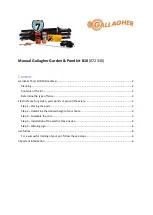
4
BATTERIES
12
4.3
MAINTENANCE ___________________________________________________________
Tool List
Insulated wrench, 9/16”
Insulated wrench, 1/2”
Battery carrier
Hydrometer
Before charging batteries
Inspect the connector housing of the battery charger and
vehicle connector housing for dirt or debris.
Charge the batteries daily after use.
Monthly
1.
Inspect all wiring for frayed wire, loose connections,
corrosion or deterioration of insulation.
2.
Check that the electrolyte level is correct and add
suitable water as required.
3.
Clean the batteries and cable terminals.
4.4
ELECTROLYTE LEVEL AND WATER__________________________________________
The correct level of the electrolyte is
at least 1/2”
(13
mm) above the plates in each cell.
A battery being charged will ‘gas’, with the majority of the
gassing taking place at the end of the charging cycle.
This gas is hydrogen which is lighter than air. Water and
sulfuric acid droplets will be carried out of the battery
vents by the hydrogen gas; however, this loss is minimal.
If the battery electrolyte level is too high, the electrolyte
will block the vent tube and the gas will
force
it out of the
vent tube and battery cap. The water will evaporate but
the sulfuric acid will remain where it can damage vehicle
components.
Sulfuric
acid
loss
will
weaken
the
concentration of acid within the electrolyte and reduce
the life of the battery.
This level will leave approximately 1/4” - 3/8” (6 - 10 mm)
of space between the electrolyte and the vent tube. The
electrolyte level is important since
any portion
of the
plates exposed to air will be ruined beyond repair. Of
equal importance is too much water which will result in
electrolyte being forced out of the battery due to gassing
and the increase in volume of the electrolyte that results
from the charging cycle.
Over the life of the battery, a considerable amount of
water is consumed. It is important the water used be pure
and free of contaminants that could reduce the life of the
battery by reducing the chemical reaction. The water
must be distilled or purified by an efficient filtration
system. Water that is not distilled should be analyzed and
if required, filtration installed to permit the water to meet
the requirements of the water purity table.
Figure 4E
WARNING
Never attach a battery charger to a vehicle that is to
be unattended. A charger failure could cause damage
to the vehicle batteries and result in extreme
overheating.
!
WARNING
Battery posts, terminals and related accessories
contain lead and lead compounds, chemicals known
to the State of California to cause cancer and
reproductive
harm.
Wash
your
hands
after
handling.
!
CAUTION
Do not overfill batteries
!
EXPANSION
SPACE
VENT CAP
1/4” - 3/8”
(6 - 10 mm
1/2”
(13 MM)
GAS
VENT
ELECTROLYTE
LEVEL
SHOULD
BE
AT
LEAST 1/2” (13 MM) ABOVE THE PLATES
AND 1/4” - 3/8” (6 - 10 MM) BELOW VENT
VENT
PLATES
TR06













































